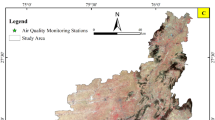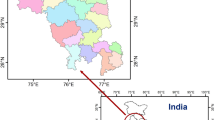Abstract
Since late 2019, SARS-CoV-2 has taken a scourge form worldwide, and to prevent the spread of this virus, a partial or complete lockdown was started. In India, the lockdown has been implemented in four phases starting from 25th March 2020. These circumstances restricted the operations of human movement, vehicles and industries, which began to improve the air quality. The aim of the present work is to enquire about air quality during the lockdown period at the national level in India and specifically in four metropolitan cities—Delhi, Mumbai, Chennai and Kolkata. The air quality data of critical air pollutants- PM2.5, PM10, SO2, NO2 and CO of pre-COVID-19 (May & June 2019; and January 2020) and COVID-19 periods (May & June 2020; and January 2021) have been analyzed based on Sentinel 5P satellite image and Indian Central Pollution Control Board data. After a thorough study, it is found that the air quality is improved during the lockdown phase but again it degrades rapidly after the lockdown. Results show that among the four selected metropolitan cities, air pollution in Kolkata is the least whereas Delhi is the most polluted city in India. But the concentration of SO2 is reduced to 20 μg/m3 in the lockdown period from 45 μg/m3 in pre-lockdown periods. Similarly, NO2 was reduced from 52 μg/m3 to 20 μg/m3; CO from 32 μg/m3 to 29 μg/m3 and aerosol concentration from 168 μg/m3 to 125 μg/m3 between pre-lockdown to lockdown periods. For other places and cities in India such air pollution reduction has been noticed. It is to be accomplished that the findings of this study could also be helpful for the policymakers and stakeholders to require some effective future initiatives to manage air quality through the partial lockdown process.


















Similar content being viewed by others
Explore related subjects
Discover the latest articles and news from researchers in related subjects, suggested using machine learning.Data availability statement
Primary data on the tiger attack already have been provided in the main text in the table. Pollution data links will be shared on request.
References
Airveda. What Is PM2.5 and Why is it important? Airveda (2017, September 25). https://www.airveda.com/blog/what-is-pm2-5-and-why-is-it-important
Bontempi, E. (2022). A global assessment of COVID-19 diffusion based on a single indicator: some considerations about air pollution and COVID-19 spread. Environmental Research, 204, 112098. https://doi.org/10.1016/j.envres.2021.112098
Britannica, Carbon monoxide | chemical compound | Britannica (2023, May 10). https://www.britannica.com/science/carbon-monoxide
Census, 2011. Delhi Metropolitan Urban Region Population 2011–2023 Census (2011). https://www.census2011.co.in/census/metropolitan/50-delhi.html
Chakraborti, S. Air pollution level in Kolkata among country’s highest. The Times of India . (2017, January 3). https://timesofindia.indiatimes.com/city/kolkata/air-pollution-level-in-kolkata-among-countrys-highest/articleshow/56310086.cms
Chatterjee, K., Chatterjee, K., Kumar, A., & Shankar, S. (2020). Healthcare impact of COVID-19 epidemic in India: a stochastic mathematical model. Med. J. Armed Forces India., 76(2), 147–155. https://doi.org/10.1016/j.mjafi.2020.03.022
Chowdhury, T., Chowdhury, H., Bontempi, E., Coccia, M., Masrur, H., Sait, S. M., & Senjyu, T. (2022). Are mega-events super spreaders of infectious diseases similar to COVID-19? A look into Tokyo 2020 Olympics and Paralympics to improve preparedness of next international events. Environmental Science and Pollution Research, 30(4), 10099–10109. https://doi.org/10.1007/s11356-022-22660-2
CPCB. AQI Air Quality Index: real-time Air Pollution Leve (2021, February 6)l. https://www.aqi.in/
Dangayach, R., Pandey, M., Gusain, D., Srivastav, A. L., Jain, R., Bairwa, B. M., & Pandey, A. K.,Assessment of Air Quality Before and During COVID-19-Induced Lockdown in Jaipur. MAPAN (2023). https://doi.org/10.1007/s12647-022-00615-9
DTE, S. Air pollution killed 1.7 million Indians in 2019: Lancet report [Organisation]. Down to Earth (2020, December 22). https://www.downtoearth.org.in/news/air/air-pollution-killed-1-7-million-indians-in-2019-lancet-report-74737
US EPA, O. Nitrogen Dioxide (NO2) Pollution [Collections and Lists] (2016a, March 7). https://www.epa.gov/no2-pollution
US EPA, O. Sulfur Dioxide (SO2) Pollution [Collections and Lists] (2016b, March 7). https://www.epa.gov/so2-pollution
US EPA, O. . Particulate Matter (PM) Basics [Overviews and Factsheets] (2016c, April 19). https://www.epa.gov/pm-pollution/particulate-matter-pm-basics
Fong S. J., Dey N., Chaki J. An Introduction to COVID-19. Artificial Intelligence for Coronavirus Outbreak, 1–22 (2020). https://doi.org/10.1007/978-981-15-5936-5_1
Gao, M., Yang, H., Xiao, Q., & Goh, M. (2022). COVID-19 lockdowns and air quality: evidence from grey spatiotemporal forecasts. Socio-Eco. Plan. Sci., 83, 101228. https://doi.org/10.1016/j.seps.2022.101228
Ghosh, B., Nayek, S., & Padhy, P. K. (2023). Effects of Nationwide Lockdown due to COVID-19 on Ambient Air Quality in the State of West Bengal. India. J. Sci. Res., 15(1), 183–200. https://doi.org/10.3329/jsr.v15i1.59249
Google for Developers. Sentinel Collections in Earth Engine | Earth Engine Data Catalog. Google for Developers (2021, October 12). https://developers.google.com/earth-engine/datasets/catalog/sentinel
Hyman, S., Zhang, J., Andersen, Z. J., Cruickshank, S., Møller, P., Daras, K., Williams, R., Topping, D., & Lim, Y.-H. (2023). Long-term exposure to air pollution and COVID-19 severity: a cohort study in Greater Manchester. United Kingdom. Environ. Pollut., 327, 121594. https://doi.org/10.1016/j.envpol.2023.121594
Jerrett, M., Nau, C. L., Young, D. R., Butler, R. K., Batteate, C. M., Su, J., Burnett, R. T., & Kleeman, M. J. (2023). Air pollution and meteorology as risk factors for COVID-19 death in a cohort from Southern California. Environment International, 171, 107675. https://doi.org/10.1016/j.envint.2022.107675
Kan, H., Wong, C.-M., Vichit-Vadakan, N., Qian, Z., & PAPA Project Teams. (2010). Short-term association between sulfur dioxide and daily mortality: the public health and air pollution in asia (PAPA) study. Environmental Research, 110(3), 258–264. https://doi.org/10.1016/j.envres.2010.01.006
Kumar, D., Malviya, R., & Sharma, P. K. (2020). Corona virus: a review of COVID-19. Eur. J. Med. Oncol., 4(1), 8–25.
Liou, Y.-A., Vo, T.-H., Nguyen, K.-A., & Terry, J. P. (2023). Air quality improvement following COVID-19 lockdown measures and projected benefits for environmental health. Remote Sensing, 15(2), 530. https://doi.org/10.3390/rs15020530
Ma, Y., Cheng, B., Li, H., Feng, F., Zhang, Y., Wang, W., & Qin, P. (2023). Air pollution and its associated health risks before and after COVID-19 in Shaanxi Province China. Environmental Pollution, 320, 121090. https://doi.org/10.1016/j.envpol.2023.121090
Naqvi, H. R., Datta, M., Mutreja, G., Siddiqui, M. A., Naqvi, D. F., & Naqvi, A. R. (2021). Improved air quality and associated mortalities in India under COVID-19 lockdown. Environmental Pollution, 268, 15691. https://doi.org/10.1016/j.envpol.2020.115691
Pai, E., Chopra, S., Mandloi, D., Upadhyay, A. K., Prem, A., & Pandey, D. (2020). Continuing surgical care in cancer patients during the nationwide lockdown in the COVID-19 pandemic—perioperative outcomes from a tertiary care cancer center in India. Journal of Surgical Oncology, 122(6), 1031–1036. https://doi.org/10.1002/jso.26134
Persis, J., & Ben Amar, A. (2023). Predictive modeling and analysis of air quality – Visualizing before and during COVID-19 scenarios. J. Environ. Manag., 327, 16911. https://doi.org/10.1016/j.jenvman.2022.116911
Purelogic Labs India Pvt Ltd. India air quality index (AQI): real-time air pollution level (2021, December 14). https://www.aqi.in/in/dashboard/india
Queensland, c=AU; o=The S. of. Sulfur dioxide | Air pollutants [Text]. corporateName=the state of queensland; jurisdiction=queensland . (2021, March 6). https://www.qld.gov.au/environment/management/monitoring/air/air-pollution/pollutants/sulfur-dioxide
Rathore, D. S., Nagda, C., Shaktawat, B. S., Kain, T., Chouhan, C. S., Purohit, R., Harish Null Khangarot, R. K., Nagda, G., & Jhala, L. S. (2021). COVID-19 lockdown: a boon in boosting the air quality of major Indian Metropolitan Cities. Aerobiologia, 37(1), 79–103. https://doi.org/10.1007/s10453-020-09673-5
Samoli, E., Aga, E., Touloumi, G., Nisiotis, K., Forsberg, B., Lefranc, A., Pekkanen, J., Wojtyniak, B., Schindler, C., Niciu, E., Brunstein, R., Fikfak, M. D., Schwartz, J., & Katsouyanni, K. (2006). Short-term effects of nitrogen dioxide on mortality: an analysis within the APHEA project. Eur. Resp. J., 27(6), 1129–1138. https://doi.org/10.1183/09031936.06.00143905
Schneider, R., Masselot, P., Vicedo-Cabrera, A. M., Sera, F., Blangiardo, M., Forlani, C., Douros, J., Jorba, O., Adani, M., Kouznetsov, R., Couvidat, F., Arteta, J., Raux, B., Guevara, M., Colette, A., Barré, J., Peuch, V.-H., & Gasparrini, A. (2022). Differential impact of government lockdown policies on reducing air pollution levels and related mortality in Europe. Science and Reports, 12(1), 726. https://doi.org/10.1038/s41598-021-04277-6
Sheppard, N., Carroll, M., Gao, C., & Lane, T. (2023). Particulate matter air pollution and COVID-19 infection, severity, and mortality: a systematic review and meta-analysis. Science of the Total Environment, 880, 163272. https://doi.org/10.1016/j.scitotenv.2023.163272
Sikary, A. K., Dixit, S., & Murty, O. P. (2017). Fatal carbon monoxide poisoning: a lesson from a retrospective study at All India Institute of Medical Sciences, New Delhi. J. Family Med. Primary Care, 6(4), 791–794. https://doi.org/10.4103/jfmpc.jfmpc_408_16
Singh Bisht, Y., Kumar Shah, S., & Singh Rana, V. Road map for ethanol blending & prospective scope towards sustainable development in Indian scenario. Materials Today: Proceedings, S2214785323014219 (2023). https://doi.org/10.1016/j.matpr.2023.03.375
Singh, R., & Subedi, M. (2020). COVID-19 and stigma: social discrimination towards frontline healthcare providers and COVID-19 recovered patients in Nepal. Asian J. Psyc., 53, 102222. https://doi.org/10.1016/j.ajp.2020.102222
Sreedhar, N. (2021, February 9). One third of deaths in India every year are due to air pollution. Mintlounge. https://lifestyle.livemint.com//smart-living/environment/onethird-of-indians-die-due-to-air-pollution-every-year-111612855290031.html
DTE Staff. Delhi is India’s most polluted megacity, but others are catching up: CSE report(2023, July 3). https://www.downtoearth.org.in/news/pollution/delhi-is-india-s-most-polluted-megacity-but-others-are-catching-up-cse-report-88109
Yao, Z., Wang, Y., Qiu, X., & Song, F. (2023). Impact of anthropogenic emission reduction during COVID-19 on air quality in Nanjing China. Atmosp., 14(4), 630. https://doi.org/10.3390/atmos14040630
Acknowledgements
I thank Susmita Mallick, PG student of the Geography Department, Barrackpore Rastraguru Surendranath College, for helping in some data processing and all faculty members of the department for being so supportive during the study.
Author information
Authors and Affiliations
Corresponding author
Ethics declarations
Conflict of interest
The author has no relevant financial or non-financial interests to disclose. The author has no competing interests to declare that are relevant to the content of this article.
Additional information
Publisher's Note
Springer Nature remains neutral with regard to jurisdictional claims in published maps and institutional affiliations.
Rights and permissions
Springer Nature or its licensor (e.g. a society or other partner) holds exclusive rights to this article under a publishing agreement with the author(s) or other rightsholder(s); author self-archiving of the accepted manuscript version of this article is solely governed by the terms of such publishing agreement and applicable law.
About this article
Cite this article
Dhar, S.B. A comparative study of air quality between pre and post COVID-19 periods in India. Environ Dev Sustain 27, 1829–1853 (2025). https://doi.org/10.1007/s10668-023-03945-z
Received:
Accepted:
Published:
Issue Date:
DOI: https://doi.org/10.1007/s10668-023-03945-z




